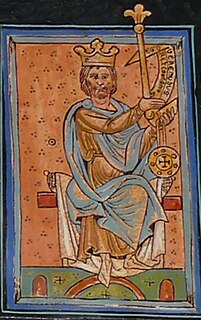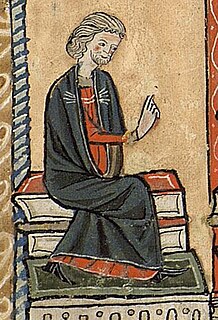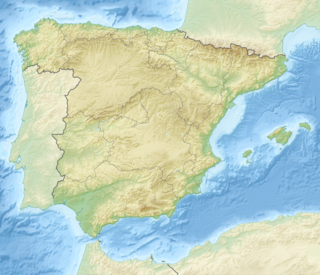Suero Gundemáriz [lower-alpha 1] (flourished 968–991) was a Leonese count in the region of Galicia, notable mainly for leading the region in rebellion. He was married to Teodegonza, [lower-alpha 2] a relative of Rudesind, founder of the monastery of Celanova. [1] He was probably a brother of Piniolo Gundemáriz and thus an uncle of Count Gundemaro Pinióliz. [2]
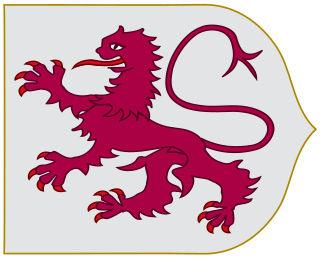
The Kingdom of León was an independent kingdom situated in the northwest region of the Iberian Peninsula. It was founded in AD 910 when the Christian princes of Asturias along the northern coast of the peninsula shifted their capital from Oviedo to the city of León. The County of Castile separated in 931, the County of Portugal separated to become the independent Kingdom of Portugal in 1139 and the eastern, inland part of León was joined to the Kingdom of Castile in 1230.
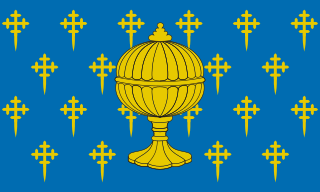
The Kingdom of Galicia was a political entity located in southwestern Europe, which at its territorial zenith occupied the entire northwest of the Iberian Peninsula. Founded by Suebic king Hermeric in 409, the Galician capital was established in Braga, being the first kingdom which adopted Catholicism officially and minted its own currency. It was part of the Kingdom of the Spanish Visigothic monarchs from 585 to 711. In the 8th century Galicia became a part of the newly founded Christian kingdoms of the Northwest of the peninsula, Asturias and León, while occasionally achieving independence under the authority of its own kings. Compostela became capital of Galicia in the 11th century, while the independence of Portugal (1128) determined its southern boundary. The accession of Castilian King Ferdinand III to the Leonese kingdom in 1230 brought Galicia under the control of the Crown of Castile, the kingdom of Galicia becoming a political division within the larger realm.
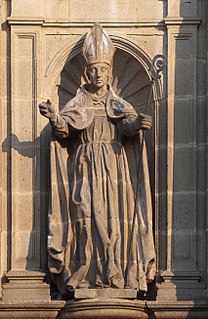
Saint Rudesind was a County of Portugal bishop and abbot. He was also a regional administrator and military leader under his kinsmen, the Kings of León.
Contents
Little is known of Suero's early life. His earliest appearance in the historical record is as a witness in a document of 968 pertaining to the monastery of Sobrado. He attended the court of King Ramiro III in 974, witnessing two royal diplomas. In 985–86, he witnessed five diplomas of King Vermudo II, all pertaining to churches in León proper and Galicia. His interests clearly lay in eastern Galicia; and not a single document places him in Portugal. [3] [lower-alpha 3]

Ramiro III, king of León (966–984), was the son of Sancho the Fat and his successor at the age of only five.

The County of Portugal refers to two successive medieval counties in the region around Braga and Porto, today corresponding to littoral northern Portugal, within which the identity of the Portuguese people formed. The first county existed from the mid-ninth to the mid-eleventh centuries as a vassalage of the Kingdom of Asturias and later the Kingdoms of Galicia and León, before being abolished as a result of rebellion. A larger entity under the same name was then reestablished in the late 11th century and subsequently elevated by its count in the mid-12th century into an independent Kingdom of Portugal.
In 986, Suero led a revolt against the King Vermudo II. He was joined by Count Gonzalo Menéndez and Osorio Díaz. This rebellion disturbed a peace which, as King Vermudo had proudly declared, reigned throughout the length and breadth of the kingdom as of 1 January 986. It also coincided with an invasion from the south by the Caliphate under al-Mansur. During the revolt, Suero managed to build a villa without royal permission at Veyga on the river Miño. [4] In 994, after Suero's death, King Vermudo gave the villa to the monastery of Celanova. In documenting this gift, the king recorded how Suero, "puffed up with pride and led by a malicious spirit, rebelled against me and disturbed my land and my rights equally and my castles too, as did his other accomplices, whom he led against me." [5] [lower-alpha 4] A document dated 1032, from the reign of King Vermudo III, describes the revolt led by Suero during the time of his grandfather (Vermudo II). It says that Suero held the fortress of Lugo and that the rebels built many illegal castles, all of which save for Lapio (now Labio) were torn down after the rebellion was defeated. [6] [lower-alpha 5]
Gonzalo Menéndez was a Count of Portugal in the Kingdom of León. He regularly carries the title count (comes), the highest in the kingdom, in surviving documents. He may have used the title magnus dux portucalensium. His name in contemporary records is usually spelled Gundisaluus Menendiz.
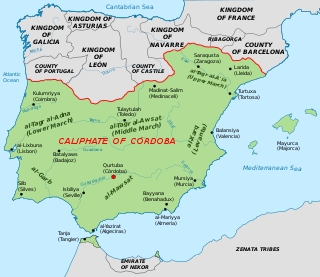
The Caliphate of Córdoba was a state in Islamic Iberia along with a part of North Africa ruled by the Umayyad dynasty. The state, with the capital in Córdoba, existed from 929 to 1031. The region was formerly dominated by the Umayyad Emirate of Córdoba (756–929). The period was characterized by an expansion of trade and culture, and saw the construction of masterpieces of al-Andalus architecture. In January 929, Abd ar-Rahman III proclaimed himself Caliph of Córdoba, replacing thus his original title of Emir of Córdoba. He was a member of the Umayyad dynasty, which had held the title of Emir of Córdoba since 756.

Abu ʿĀmir Muḥammad ibn ʿAbdullāh ibn Abi ʿĀmir, al-Ḥājib al-Manṣūr, better known as Almanzor, was for 24 years (978–1002) the de facto ruler of al Andalus under the Umayyad Caliphate of Córdoba. His rule marked the peak of power for al-Andalus. Some say that he claimed the title of a King, and was known as Al Malik Al Mansur.
Suero made his peace with the king in 988, and was re-admitted to the royal court. Despite the fact that his rebellion was remembered for decades on account of its gravity, he was shown tremendous leniency, although his lands were at least partially confiscated. On 23 December 988, in a royal diploma for Celanova, he appears atop the list of lay witnesses. [3] On 1 March 991, in his last appearance in the records, he confirms Vermudo II's grant of the conmiso (district) of Mera to the cathedral of Lugo. [7] He died later that year. On 10 August 992, some estates that had been confiscated after the rebellion were conferred on his widow. [8] [9] [10] His widow was alive as late as 18 December 1016, when she donated half the villa of Meilán to the cathedral of Lugo. [11] One of Suero's nephews, Rodrigo Romániz, led a rebellion from the region of Monterroso during the reign of King Vermudo III, and seized the castle of Lapio. [1]
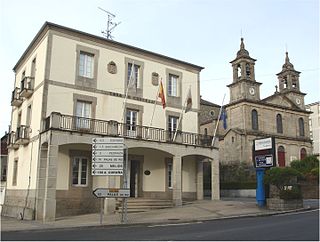
Monterroso is a municipality in Lugo province in Galicia in north-west Spain.

